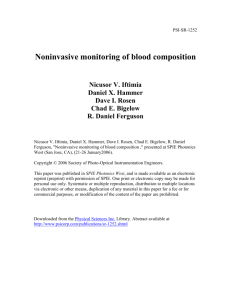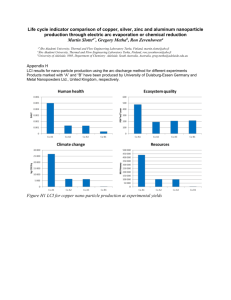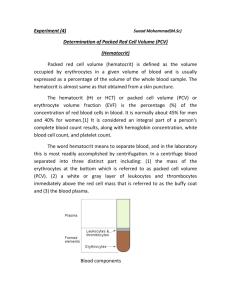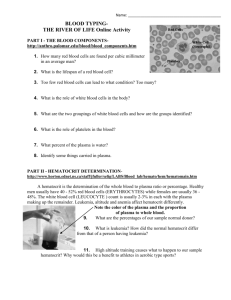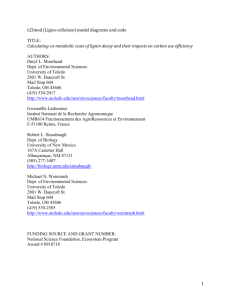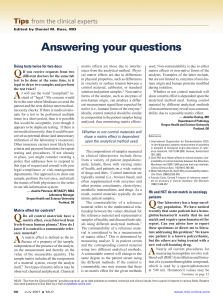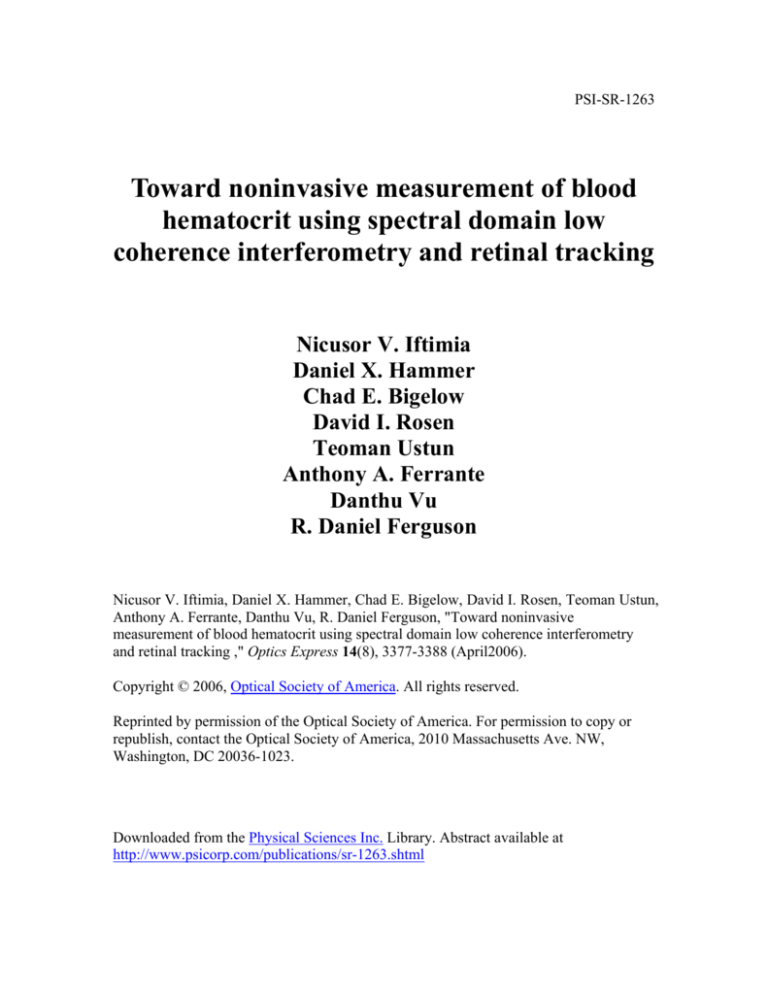
PSI-SR-1263
Toward noninvasive measurement of blood
hematocrit using spectral domain low
coherence interferometry and retinal tracking
Nicusor V. Iftimia
Daniel X. Hammer
Chad E. Bigelow
David I. Rosen
Teoman Ustun
Anthony A. Ferrante
Danthu Vu
R. Daniel Ferguson
Nicusor V. Iftimia, Daniel X. Hammer, Chad E. Bigelow, David I. Rosen, Teoman Ustun,
Anthony A. Ferrante, Danthu Vu, R. Daniel Ferguson, "Toward noninvasive
measurement of blood hematocrit using spectral domain low coherence interferometry
and retinal tracking ," Optics Express 14(8), 3377-3388 (April2006).
Copyright © 2006, Optical Society of America. All rights reserved.
Reprinted by permission of the Optical Society of America. For permission to copy or
republish, contact the Optical Society of America, 2010 Massachusetts Ave. NW,
Washington, DC 20036-1023.
Downloaded from the Physical Sciences Inc. Library. Abstract available at
http://www.psicorp.com/publications/sr-1263.shtml
Toward noninvasive measurement of blood
hematocrit using spectral domain low coherence
interferometry and retinal tracking
Nicusor V. Iftimia, Daniel X. Hammer, Chad E. Bigelow, David I. Rosen, Teoman Ustun,
Anthony A. Ferrante, Danthu Vu, and R. Daniel Ferguson
Physical Sciences. Inc, 20 New England Business Ctr. Drive, Andover, MA 01810
iftimia@psicorp.com, ferguson@psicorp.com
Abstract: We demonstrate in vivo measurements in human retinal vessels of an
experimental parameter, the slope of the low coherence interferometry (LCI) depth
reflectivity profile, which strongly correlates with the real value of blood hematocrit.
A novel instrument that combines two technologies, spectral domain low coherence
interferometry (SDLCI) and retinal tracking, has been developed and used for these
measurements. Retinal tracking allows a light beam to be stabilized on retinal
vessels, while SDLCI is used for obtaining depth-reflectivity profiles within the
investigated vessel. SDLCI backscatter extinction rates are obtained from the initial
slope of the A-scan profile within the vessel lumen. The differences in the slopes of
the depth reflectivity profiles for different subjects are interpreted as the difference
in the scattering coefficient, which is correlated with the number density of red blood
cells (RBC) in blood. With proper calibration, it is possible to determine hematocrit
in retinal vessels. Ex vivo measurements at various RBC concentrations were
performed to calibrate the instrument. Preliminary measurements on several healthy
volunteers show estimated hematocrit values within the normal clinical range.
2005 Optical Society of America
OCIS codes: (170.3880) Medical and biological imaging; (120.3890) Medical optics instrumentation.
References and links
1. C. Johner, P. Chamney, D. Schneditz, and M. Krämer, “Evaluation of an ultrasonic blood volume monitor”,
Nephrol. Dial. Transplant. 13, 2098–2103 (1998).
2. W. Secomsky, A. Nowicki, F. Guidi, P. Tortoli, and P.A. Lewin, “Non-invasive measurement of blood
hematocrit in artery”, Bulletin of the Polish Academy of Sciences, 53 (3), 245-50 (2005).
3. J.M. Schmitt, Z Guan-Xiong, and J. Miller, “Measurement of blood hematocrit by dual-wavelength near-IR
photoplethsymography, “ Proc. SPIE 1441, 150-161 (1992).
4. A. F. Fercher, W. Drexler, C. K. Hitzenberger and T. Lasser, “Optical coherence tomography- principles and
application,” Rep. Prog. Phys. 66. 239-303 (2003).
5. R. Leitgeb, C. K. Hitzenberger, and A. F. Fercher, “Performance of Fourier domain vs. time domain optical
coherence tomography,” Opt. Express 11, 889-894 (2003),
http://www.opticsexpress.org/abstract.cfm?URI=OPEX-11-8-889.
6. S. H. Yun, G. J. Tearney, J. F. de Boer, N. Iftimia, and B. E. Bouma, “High-speed optical frequency-domain
imaging,” Opt. Express 11, 2953-2963 (2003), http://www.opticsexpress.org/abstract.cfm?URI=OPEX-11-222953.
7. J.F. de Boer, B. Cense, B.H. Park, et al., "Improved signal-to-noise ratio in spectral-domain compared with
timedomain optical coherence tomography," Opt. Lett. 28, 2067-2069 (2003).
8. N.A. Nassif, B. Cense, B.H. Park, et al., "In vivo high-resolution video-rate spectral-domain optical coherence
tomography of the human retina and optic nerve," Opt. Express 12, 367-376 (2004),
http://www.opticsexpress.org/abstract.cfm?URI=OPEX-12-3-367.
9. A. Gh. Podoleanu, M. Seeger, G. M. Dobre, D. J. Webb, D. A. Jackson and F. Fitzke, “Transversal and
longitudinal images from the retina of the living eye using low coherence reflectometry,” J. Biomed. Opt. 3, 12(1998).
10. H. Liang, M. G. Cid, R. G. Cucu, G. M. Dobre, A. G. Podoleanu, J. Pedro, and D. Saunders, "En-face
optical coherence tomography – a novel application of non-invasive imaging to art conservation," Opt. Express
13, 6133-6144 (2005), http://www.opticsexpress.org/abstract.cfm?URI=OPEX-13-16-6133.
11. B.R. White, M.C. Pierce, N. Nassif, et al., "In vivo dynamic human retinal blood flow imaging using ultrahighspeed spectral domain optical Doppler tomography," Opt. Express 11, 3490-3497 (2004),
http://www.opticsexpress.org/abstract.cfm?URI=OPEX-11-25-3490.
12. J. Zhang and Z. Chen, "In vivo blood flow imaging by a swept laser source based Fourier domain optical
Doppler tomography," Opt. Express 13, 7449-7457 (2005),
http://www.opticsexpress.org/abstract.cfm?URI=OPEX-13-19-7449.
13. C. Xu, D. L. Marks, M. N. Do, and S. A. Boppart, "Separation of absorption and scattering profiles in
spectroscopic optical coherence tomography using a least-squares algorithm," Opt. Express 12, 4790-4803
(2004), http://www.opticsexpress.org/abstract.cfm?URI=OPEX-12-20-4790.
14. B. Hermann, K. Bizheva, A. Unterhuber, B. Povazay, H. Sattmann, L. Schmetterer, A. F. Fercher and W.
Drexler, "Precision of extracting absorption profiles from weakly scattering media with spectroscopic timedomain optical coherence tomography," Opt. Express 12, 1677-1688 (2004).
15. D. X. Hammer, R. D. Ferguson, N. V. Iftimia, T. Ustun, G. Wollstein, H. Ishikawa, M. L. Gabriele, W. D.
Dilworth, L. Kagemann, and J. S. Schuman, "Advanced scanning methods with tracking optical coherence
tomography," Opt. Express 13, 7937-7947 (2005),
http://www.opticsexpress.org/abstract.cfm?URI=OPEX-13-20-7937.
16. D. P. Wornson, G. W. Hughes, and R. H. Webb, “Fundus tracking with the scanning laser ophthalmoscope,”
Appl. Opt. 26, 1500-1504 (1987).
17. T. N. Cornsweet and H. D. Crane, “Servo-controlled infrared optometer,” J. Opt. Soc. Am. 60, 548-554 (1970).
18. M Yu Kirillin, A.V. Priezzhev, V V Tuchin, R K Wang, and R Myllylä, “Effect of red blood cell aggregation
and sedimentation on optical coherence tomography signals from blood samples”, J. Phys. D: Appl. Phys. 38
2582-2589 (2005).
19. D. X. Hammer, R. D. Ferguson, J. C. Magill, M. A. White, A. E. Elsner, and R. H. Webb, "Image
stabilization for scanning laser ophthalmoscopy," Opt. Express 10, 1542-1549 (2002),
http://www.opticsexpress.org/abstract.cfm?URI=OPEX-10-26-1542.
20. G. Hausler and M. W. Lindner, “Coherence radar and spectral radar - new tools for dermatological diagnosis,”
J. Biomed. Opt. 3, 21-31 (1998).
21. M. Wojtkowski, V. J. Srinivasan, T. H. Ko, J. G. Fujimoto, A. Kowalczyk, and J. S. Duker, "Ultrahighresolution, high-speed, Fourier domain optical coherence tomography and methods for dispersion
compensation," Opt. Express 12, 2404-2422 (2004), http://www.opticsexpress.org/abstract.cfm?URI=OPEX12-11-2404.
22. L. Thrahe, M.H. Frosz, T.M. Jørgensen, A. Tycho, H.T. Yura, P.E. Andersen, “ Extraction of optical scattering
parameters and attenuation compensation in optical coherence tomography images of multilayered tissue
structures”, Opt. Lett. 29(14), 1641-43 (2004).
23. D. J. Faber, E.G. mick, M.C.G. Aalders, T.G. van Leeuwen, “Light absorption of (oxy-)hemoglobin assessed by
spectroscopic optical coherence tomography”, Opt. Lett 28(16), 1436-38 (2003).
24. D. J. Faber, E.G. Mick, M.C.G. Aalders, T.G. van Leeuwen, “Toward assessment of blood oxygen saturation
by spectroscopic optical coherence tomography”, Optt. Lett. 30(9), 1015-17 (2005).
25. J.M. Steinke and A.P. Shepherd, “Diffusion model of the optical absorbance of whole blood”, J. Opt. Soc. Am.
A 5, 813-822 (1988).
26. A. Roggan, M. Friebel, K. Dörschel, A. Hahn, and G. Müller, “Optical Properties of Circulating Human Blood
in the Wavelength Range 400–2500 nm”, Journal of Biomedical Optics 4(1), 36-46 (1999).
1. Introduction
Blood hematocrit is defined as the volume percentage of the blood that consists of red blood
cells (RBC’s). Non-invasive monitoring of hematocrit would be quite valuable for many
clinical applications. Rapid determination of hematocrit, on a periodic or continuous
monitoring is essential for patients with blood disorders, in emergency situations, post
operatively, or with therapies that compromise blood-forming functions and organs.
Several noninvasive methods have been proposed for hematocrit measurements.
Ultrasound-based continuous hematocrit measurement has been proposed by Johner et al. [1].
They determined the value of hematocrit by monitoring changes in ultrasound wave velocity
propagation in plasma as a function of RBC’s concentration. Although they reported good
correlation between their measurements and the real value of the hematocrit, they noted that
the uncertainty of the method depended markedly on even minute temperature variations. A
Doppler ultrasound method has been tested as well by Secomski et al. [2]. Their results
demonstrated that hematocrit could be non-invasively determined in the brachial artery to
within an error of 5%. However, it was observed that the lateral movement of the vessel
induces additional errors. To keep the error within 5% very sophisticated multiple gated
Doppler circuitry was necessary. Near infrared (NIR) optical imaging of the blood vessels
through skin has been tested by Schmitt et al. [3] for noninvasive hematocrit measurement.
Unfortunately, lack of direct access to blood vessels alters the result of the measurements due
to the variation of the skin’s optical properties from one person to another.
In this paper we show noninvasive estimation of blood hematocrit by using low
coherence interferometry (LCI) and directly accessing small vessels of the retina. The slope
of the LCI depth reflectivity profile is used to determine hematocrit information.
LCI has become a powerful technique that is largely used in optical coherence
tomography (OCT) to obtain cross sectional images of biological tissues. Standard OCT
images are based on the intensity of backscattered or backreflected optical radiation. In the
standard time-domain (TD) implementation of LCI, a mirror is rapidly scanned in the
reference arm of the interferometer in order to obtain a depth reflectivity profile within a
sample. An alternative method of retrieving depth information examines the cross-spectral
density to reconstruct the interferogram by detecting the interference signal as a function of
wavelength [4,5]. This method, known as spectral-domain (SD) LCI, does not require
modulation of the reference arm length and therefore has potential for faster acquisition rates.
Although this method was demonstrated years ago, only recently has it been explicitly shown
that SD implementation of OCT (and LCI) has vastly superior detection sensitivity compared
to the time domain method. Recent work has experimentally demonstrated a 148-fold (21.7
dB) sensitivity improvement with SDOCT [6].
SDLCI is used in ophthalmology to obtain cross-sectional or en face images of the retina
[7-9], to measure Doppler flow in the retinal vessels [10,11], or for spectroscopic
measurements [12,13]. However, due to the strong forward scattering of blood, SDLCI
measurements require relatively long exposure durations to collect enough photons to achieve
adequate signal-to-noise levels within the confines of laser safety requirements.
Unfortunately, eye movement makes such measurements difficult. The light beam
interrogating the eye must be stabilized on a fixed location on a specific retinal vessel to
collect reproducible depth-reflectivity profiles in the blood. This is possible only by
employing an eye motion stabilization technique. Eye motion stabilization can generally be
accomplished invasively with suction cups or retrobulbar injections, inaccurately with
fixation, more precisely at slower speeds with a passive image processing approach, or at high
speeds with active tracking [14,15]. Fixation requires patient cooperation and is difficult in
patients with poor vision. Other active tracking techniques, such as double-Purkinje trackers
[16,17], are specifically designed for the anterior segment and are less reliable for
measurement of retinal position.
We demonstrate that the combination of two technologies, direct retinal tracking with
tracking scanning laser ophthalmoscopy (TSLO), and SDLCI, is suitable for non-invasive
measurement of blood hematocrit level (H). Preliminary measurements on several volunteers
show that noninvasive blood hematocrit estimates correlate well with conventional clinical
methods.
2. Methods and materials
2.1. Theoretical approach
To illustrate the basic methodology, a relatively simple theoretical model was used to
extract the hematocrit level from the depth (axial) reflectivity profile by simply measuring its
slope and applying a scaling factor. The amplitude S of the LCI fringes is proportional to the
square root of the light intensities Is and Ir returning from the sample and the reference arm of
the interferometer, respectively:
(1)
S LCI ( z ) = k [ I r I s ( λ , z )]1/ 2 ,
k denotes a constant factor that is given by the LCI system specifications (e.g. detector
responsitivity). Is(λ,z) depends on the reflectivity of the sample at a depth z within the sample,
the signal intensity caused by coherent superposition of the electromagnetic fields from
different scatters within the coherence volume, and the position of the focal spot within the
sample.
The intensity of the light from the sample arm that propagates through the sample can be
described by Beer’s law:
(2)
I s ( λ , z ) = I s 0 ( λ ) exp{ −[ µ a ( λ , z ) + µ s ( λ , z )] z } ,
where Is0 denotes the incident intensity, λ the wavelength, µa the absorption coefficient, and
µs the total scattering coefficient. However, for the SDLCI case, mostly singly scattered
photons are detected. Some multiple scattered photons fall within the coherence gate with a
measurable contribution to the slope of the SDLCI depth reflectivity profile. As a result, the
experimental slope of the LCI reflectivity profile is reduced: neither the true scattering
coefficient µs , nor the reduced value µs′ is actually appropriate for our calculation. With the
provision that µs is actually a bandwidth-dependent parameter, µs-LCI, if we take the
logarithm of Eq. (1) and use Eq. (2) we obtain:
ln[ S LCI ( z )] = ln{k [ I r (λ ) I s 0 (λ )]1/ 2 } − {[ µ a (λ , z ) + µ s − LCI (λ , z )] z}
(3)
where we have taken into account the double pass configuration of the LCI signal.
With the assumption of a constant incident and reference intensity, eq. (3) is a linear
function in z and the initial slope s in the lumen is given by:
(4)
s = −[ µ a (λ , z ) + µ s − LCI (λ , z )]
By choosing a light source with the central wavelength within the 700 nm to 900 nm
spectral interval, where the absorption coefficient of light in blood is small compared to the
total scattering coefficient, the influence of µa in eq. (4) is minimized and can be regarded as
an approximately constant factor. Measurements performed by other research groups [18,19]
show that at around 800 nm µa is almost two orders of magnitude lower than µs (µa ≅ 0.82
mm-1,
µs ≅ 57 mm-1). Slope changes in eq. (4) are therefore a direct measure of the
scattering coefficient, µs-LCI, which depends upon the volume fraction of RBC’s (i.e.
hematocrit).
Based on the above arguments, the hematocrit level can be estimated directly by
measuring the slope of the LCI depth reflectivity profile and applying a scaling factor
determined from blood samples with a known hematocrit value. However, second order
corrections will be required for significantly microcytic or macrocytic cells.
2. 2. Instrumentation
In principle, in vivo hematocrit measurements can be performed with an SD-LCI instrument
and a camera for ocular fundus imaging. However, in order to stabilize the beam on the
retinal vessel, a retinal motion tracker is necessary. A tracking scanning laser opthalmoscope
(TSLO) and an SDLCI/OCT system were integrated into a single platform. The schematic of
the TSLO/SDLCI instrument is shown in Fig. 1.
TSLO is used to provide an image of the retina and stabilize the SDLCI/OCT beam on
retinal vessels. The TSLO system consists of a custom-designed confocal line scanning laser
ophthalmoscope (LSLO) and a retinal tracker. A complete description of these systems can be
found elsewhere [15,19].
The LSLO portion of the system consists of an illumination source (940 nm laser diodeRLT9510MG, Roithner LaserTechnik, Austria), a custom-made confocal reflectometer, a
linear array CMOS detector (PDI-1200, Fairchild Imaging), a scanner (Model 6200H,
Cambridge Technology, Inc.), and imaging lenses (scan lens and ophthalmoscopic lens). For
LSLO imaging, less than 0.5 mW from the laser diode is incident on the eye. The line scanner
simultaneously scans a line across the ocular fundus and de-scans the backscattered return
onto a custom linear CMOS array camera. Since the LSLO uses confocal line illumination
rather than a flying spot design, it is confocal in only one dimension.
The retinal tracking portion of the instrument consists of a confocal tracking
reflectometer, dither scanners (16 kHz resonant scanners, Electro-Optical Products
Corporation), and two tracking galvanometers (Model 6220H, Cambridge Technology, Inc.).
The system works by steering the entire image raster produced by the imaging galvanometer
with the motion of the eye using tracking mirrors. A tracking beam, locked onto a retinal
feature, senses the motion of the eye. The confocal reflectometer is used to collect only light
reflected from the plane of the fundus. The error signals generated by the system are therefore
not affected by reflections from the cornea and lens. The source for the tracker beam is a 1064
nm light-emitting diode (RLT1060-10MG, Roithner LaserTechnik, Austria) coupled to a
single mode fiber. The power of the diode is adjusted such that the tracker beam power that
reaches the cornea is slightly less than 100 µW. A PIN InGaAs photo-diode (PerkinElmer,
model C30619G), connected to a custom-made low noise/high gain transimpedance amplifier,
is used to detect the weak reflectance signal. The tracking beam is dithered in a circle with
dither scanners driven at their resonant frequency of about 16 kHz and with 90◦ phase
separation between x and y scanners. When the tracking beam passes over a retinal feature
with brightness different from the background, the retro-reflected signal contains a 16-kHz
signal, the phase and amplitude of which are determined by the direction and displacement of
the tracking beam with respect to the feature. Phase-sensitive detection with a lock-in
amplifier is employed to create error signals, which are then fed into a DSP feedback control
loop (tracking module). The control loop drives the tracking galvanometers so that the
imaging raster and SDLCI/OCT beams remain locked to the retina.
Fig. 1. General optical layout of the TSLO/SDLCI instrument.
The SD-LCI/OCT system consists of a broadband light source, a fiber-optic
interferometer, and a spectral detection and data processing unit. A broadband superluminescent diode (SLD-37MP, Superlum-Russia) with 830 nm central wavelength and 50
nm bandwidth is used as a light source. According to eq. (5), the theoretical axial resolution lz
obtained with this light source is ~ 6 µm in air and ~ 4.5 µm in biological tissue: [20]
λ20
,
l z = 0.44
n ∆λ
(5)
where λ0 is the center wavelength, ∆λ is the spectral width of the light source, and n is the
refractive index of the sample.
The fiber optic interferometer consists of a 50/50 fiber optic beam-splitter that has four
arms: the illumination arm, the sample arm, the reference arm, and the detection arm. Light
from the light source is split in two within the sample and reference arms. A fraction of the
light transmitted to the sample arm is backscattered from the sample, passes back into the
interferometer and mixes with the reference beam. This light passes back to the input arms,
being equally split between the detector arm and the illumination arm. An isolator is placed in
the illumination arm to prevent this light from going back to the light source. An optical delay
line (ODL), consisting of a mirror placed on a translation stage and a neutral density filter
(NDF) is placed in the reference arm to match the length of the sample arm. The polarization
of the reference beam is adjusted with a paddle polarization controller to match the
polarization of the light from the sample arm. This adjustment ensures that polarization
changes caused by bending and rotation of the optical fiber in both the sample and reference
arms do not wash out the interference fringes.
The core of the SDLCI/OCT system is the spectral detection unit. The optical spectrum is
dispersed by a holographic diffraction grating (Wasatch Photonics, 1200 lines per mm) and
imaged by a custom designed lens system onto a Silicon CCD array line scan camera (L104k,
Basler Vision, Inc.). The CCD has 1024 detector pixels with a 10 µm pitch and can operate at
a maximum line readout rate of 58.5 kHz. Spectrometer resolution, δλ, of about 0.2 nm was
obtained. The output of the camera is digitized by a camera link board (NI PCI-1429). The
sampled data are transferred continuously to computer memory. The usual λ to ω (or k)
interpolation was performed for our spectrometer. A discrete Fourier transform (DFT) is
performed on each set of 1024 data points acquired by the CCD to produce an axial depth
profile of the sample (A-line). Using this system a penetration depth of about 750 microns
was possible in retinal tissue at a SNR of about 100 dB.
The LCI beam is sent to the eye by means of a scanning mirror pair that allows for beam
positioning on the desired retinal vessel. These mirrors can also be used to scan the beam
across the retina and generate OCT images.
The TSLO/SD-LCI system is controlled by a P4/3 GHz computer using LabView
software. An interactive graphic user interface (GUI), shown in Figure 2, is used for setting
system parameters, data acquisition, processing, and storage.
In order to achieve the optimal resolution consistent with the light source bandwidth, it
was necessary to carefully match dispersion between the two arms of the interferometer. The
standard technique balances the dispersion of the sample by arranging a dispersive material in
the reference arm. However, this method requires adjustment from one sample to another.
Our numeric dispersion algorithm enables automatic dispersion correction of depth
reflectivity profiles at different positions with the eye. A Hilbert transform is used to calculate
the complex representation of the light source spectrum and determine the phase function.
The phase of the signal is modified by a polynomial equation in an iterative loop. A similar
approach was described by M. Wojtkowski et al. [21] for automatic dispersion compensation
in high resolution OCT imaging. They used the sharpness of the image as criterion for
optimum dispersion compensation. We use the variance of each A-line summed over the local
OCT image frame as the objective function to be maximized. A schematic of this algorithm is
shown in Figure 3. The phase, φ(ω), of the signal is iteratively corrected until the variance of
the depth reflectivity profiles are maximized. Once the locally correct phase function has been
calculated, the spectra are reconstructed and Fast Fourier transformed to derive the corrected
depth reflectivity LCI profiles in real time. LCI “M-scans” (a single A-line repeatedly
acquired in time without transverse scanning) are automatically segmented and average
slopes in the lumen are obtained.
-H 46
Fig. 2. TLSLO/SDLCI GUI interface
S(ω)
Hilbert
transform
s(τ)
φ(ω)
Complex
spectrum S*(ω ) ρ(ω)
Calculate and maximize the
Objective function
Polinomial fit
φ1(ω), φ2(ω), φ3(ω),......
FFT
φ(ω)+ Σφi
Reconstructed
spectrum S(ω)
Fig. 3. Schematic of the automated dispersion compensation algorithm.
A model eye with a partially reflecting mirror at the back end was filled with water and
used to test the effectiveness of our dispersion compensation algorithm. The axial point
spread function (PSF) with the dispersion correction turned “off” and “on” is shown in Figure
4. The full-width at half maximum (FWHM) of the axial PSF was approximately 6.0 µm with
dispersion correction and slightly over 17 µm without dispersion correction. The small
discrepancy between the experimental and the theoretical FWHM values may be attributed to
aberrations of the spectrometer or to insufficiently high order of the polynomial fit.
1
1
~ 17 microns at 3 dB
0.1
0.01
1E-3
~ 6 microns at 3dB
b)
Normalized amplitude
Normalized amplitude
a)
0.1
0.01
1E -3
0
25
50
75 100 125 150 175 200 225 250
Depth [ µ m]
60
80
100
120
140
160
180
200
Depth [ µ m ]
Fig. 4. The axial PSF (normalized power spectrum of the interference fringes), a) without dispersion
compensation and b) with dispersion compensation
3. Results and discussion
Optical properties of blood are difficult to be determined with LCI (OCT) since several
factors, like the anisotropy factor g, the O2-saturation dependent scattering, the contribution of
multiply scattered photons [22], and wavelength dependence of the absorption coefficient
[23,24] can substantially affect the results of the measurements.
In general, the effects of anisotropy and multiple scattering are difficult to compensate
[22]. However, these effects would be expected to be constant factors in normo-cytic
subjects, and thus able to be calibrated. It is also well known that the scattering coefficient is
not linearly dependent with H, as described by J.M. Schmitt [3], and modeled by and modeled
by Steinke [25]. However, it has been shown that for H values up to about 55%, the strength
of the backscattered signal is proportional with the RBC number density and the mean
corpuscular volume (MCV) [3,26].
The O2-saturation dependence of scattering and the wavelength dependence of the
absorption can be minimized by choosing the SDLCI band near the isobestic point (~805nm).
At normal physiologic oxygen tension in arterial blood, this effect has, in general, a small
systematic effect with even smaller inter- and intra-subjects variation.
SDLCI system parameters, like focusing depth, spectrometer linearity, etc. can also affect
the results of the measurements. However, a careful calibration of the system can eliminate
the effects of these factors.
3. 1 In vitro study
In vitro measurements on sheep blood samples (Hemostat Laboratories) were performed with
our instrument. The goal of the ex vivo study was to evaluate the effects of both system
parameters and blood on the results of the measurements, to calibrate the system, and evaluate
its capability to discriminate between different hematocrit levels.
Various hematocrit levels were obtained by mixing whole blood with blood serum
obtained through centrifugation. The hematocrit of each blood sample was determined by
measuring the ratio of the sedimented volume of red blood cells obtained after centrifugation
to the total blood volume. LCI measurements were taken while blood was flown through a
glass slab capillary tube with 3 mm width and 300 µm height (World Precision Instruments,
Inc.). A programmable syringe pump (NE-501, New Era Pump Systems, Inc.) was used to
flow the blood with an approximately constant speed (1mm/sec).
The slope of the LCI signal was computed and the hematocrit level was determined using
a scaling factor. This scaling factor was determined using the real value of blood hematocrit.
Representative LCI profiles for three different hematocrit values are shown in Figure 5.
40
40
40
45% HCT
50% HCT
40% HCT
20
10
30
Intensity [dB]
30
Intensity [dB]
Intensity [dB]
30
20
10
0
10
0
0
200
400
600 800 1000 1200 1400
Depth [µ m]
20
0
0
200 400 600 800 1000 1200 1400
0
200 400
Depth [µ m]
600 800 1000 1200 1400
Depth [µ m]
Fig. 5. LCI depth reflectivity profile for sheep blood samples with three different hematocrit ratios.
It can be noticed that the slope of the LCI signal decreases with the hematocrit decrease,
which is in good agreement with the theoretical predicted behavior (see eq. (4)). A lower
hematocrit means a lower scattering coefficient, and as a result a smaller LCI slope.
Statistical measurements were performed to check the stability of the slope for the same
blood sample. Sets of 20 measurements on different locations of the same sample were
performed and 10,000 LCI depth reflectivity profiles (A-lines) were averaged for each data
set. Blood samples with hematocrit values of 35%, 40%, 45%, 50%, 55%, 60%, and 65 %
were used. The results of the measurements are plotted in Fig. 6.
Measured data
Linear fit
(first 5 data points)
LCI slope [dB/mm]
75
17.25
70
16.10
65
14.95
60
13.80
55
12.65
Linear region
50
Saturation
region
11.50
45
LCI slope [1/mm]
80
10.35
35
40
45
50
55
Hematocrit [%]
60
65
Fig. 6. Variation of the LCI slope with the hematocrit value.
The slope of the LCI reflectivity profile has almost a linear behavior for hematocrit
values below 0.55, while for higher hematocrit values the slope appears to saturate and
perhaps change its sign. This behavior is a consequence of the non-linear relationship
between the concentration of the scatters (RBC’s) and the scattering coefficient. At very high
concentrations of RBC the scattering coefficient starts to saturate or even decrease. This is
probable due to a percolation effect, where light effectively spends more time traversing
islands of the dominant RBC phase than in plasma. A similar behavior (H*(1-H)) has been
described by J.M. Schmitt [3].
With regard to the value of the LCI extinction parameter, our measurements confirm the
assumptions made in our theoretical model: neither the true scattering coefficient µs , nor the
reduced value µs′ is appropriate to be used for LCI modeling. As shown in Figure 6, a 50%
hematocrit value corresponds to a slope of about 68dB/mm, which according to eq. (4) is
equivalent to a total extinction coefficient of about 15.64 mm-1. Considering a µa of about 0.8
mm-1 at around 800 nm [26], a µs-LCI of 14.84 mm-1 is obtained. This value doesn’t agree with
either the true scattering coefficient (about 50 to 80 mm-1) or the reduced one (2 to 5 mm-1)
[18,26].
3.2 In vivo study
The in vivo study was performed on 7 healthy volunteers (4 males and 3 females) with ages
between 25 and 65. The measurements were performed by accessing superficial retinal
vessels and analyzing averaged one-dimensional SD-LCI axial reflectivity profiles. Eye
motion stabilization was done with the TSLO instrument. Retinal LSLO images were used to
localize vessels and place the LCI beam on the vessel. Multiple LCI reflectivity profiles were
averaged and computed to extract the hematocrit value.
First, the capability of our system to stabilize the LCI beam on a retinal vessel was
determined. With the tracking function turned “on” and “off”, both LSLO and SDOCT
images were taken at 10 frames per second and the tracking accuracy was analyzed. The
cross-sectional OCT images were obtained by scanning the LCI beam across the retina. A
representative TSLO retinal image of a volunteer is shown in Figure 7.a). Cross-sectional
OCT images of the retina for the same volunteer are shown in Figures 7.b) and 7.c).
Quantitative tracking accuracy has been determined from blood vessel shadows from OCT
images taken from all 7 volunteers. The maximum standard deviation in blood vessel shadow
edge was less than 0.05 deg rms (15 µm) with tracking compared to approximately 0.25 deg
rms without tracking but with target fixation. A similar tracking resolution was previously
reported [15]. This tracking accuracy was enough to ensure that the LCI beam, with a lateral
point spread function of about 25 microns, can be maintained during our measurements
within the lumen of retinal vessels having at least 100 microns in diameter.
b)
a)
c)
Fig. 7. a) TSLO retinal image of a volunteer. b). OCT image along the horizontal dotted line from (a). c). OCT
image along the vertical dotted line from (a).
The depth of focus of the LCI/OCT beam in the eye is of the order or 1mm (twice the
Rayleigh range for 25 micron beam waist at the retina). We expect that geometric focus
effects over the measurable extinction range of the LCI signals (~200µm) are quite small.
Further, the use of the LSLO image for focusing, whose image plane is set to be parfocal with
the LCI/OCT beam, assures consistent LCI focus.
The LCI beam power was limited to less than 500 microwatts. This is orders of
magnitude less than the ANSI MPE for the exposure times (a few seconds) used for nonscanning LCI measurements.
After ensuring that tracking accuracy was satisfactory for our measurements, the
hematocrit study was performed. LCI reflectivity profiles were taken in major retinal vessels
with diameters > 200 microns. Vessels situated in the vicinity of the nerve optic head where
selected because they are close to the tracked point (typically lamina cribrosa), and allow
more than 100 microns sampling depth.
Six sets of multiple LCI measurements at various time intervals were taken for each
volunteer and 10,000 or more LCI depth reflectivity profiles were acquired over a second or
more and averaged in each data set. The first four volunteers were males and last three were
females. The slope of the reflectivity profile was extracted for each set of measurements. The
variation of the slope for each individual is shown in Figure 8.a). Note that a higher slope
was obtained for most of the males. The largest variation of the slope for the same individual
within the six sets of measurements was 11 dB/mm (volunteer 2), which represents about
15.7% of the mean value.
The loss of LCI signal strength with depth due to the MTF of the spectrometer (~15dB )
was corrected in the averaged profiles. However, some residual variation of the slope is due in
part to z motion of the patient because the peak of the reflectivity profile moves within the Aline axial scan and even goes out of the measuring depth of the system. Z- tracking or
automated A-scan alignment will assure that the leading edge of the lumen will always be
correctly registrated. These improvements will be incorporated in future work.
The hematocrit was computed from the slope of the LCI reflectivity profile using a
scaling factor determined from the sheep blood measurements. However, since accompanying
clinical CBCs were not included in our IRB protocol, the calibration curve and scaling factor
is likely to be slightly different for human blood and as a result our present measured
hematocrit values are only orientative. The only relevant correlation can be done for volunteer
number 4, who has been identified as having his blood work recently performed. The
hematocrit of this volunteer was pegged to the clinically measured value, approximately 42%,
which is the lower normal limit for males. The estimated hematocrit value for each individual
was then compared with the normal clinical range for both men and women. As shown in Fig.
8.b) our measurements indicate hematocrit values ranging within the normal limits for both
males and females.
H[%]
60
80
(1)
75
Slope [dB/mm]
70
65
60
54
42
55
50
M
F
46
36
Female
normal range
40
30
20
10
45
M
M
M
1
2
3
M
F
F
F
4
5
6
7
0
40
1
a)
Male
normal range
50
Hematocrit [%]
(2)
(3)
(4)
(5)
(6 )
2
3
4
Volunteer
5
6
7
b)
Volunteer
Fig. 8. a) LCI slope statistics for 7 volunteers; b) Histogram showing the correlation of the measured
hematocrit with the normal clinical range.
In order to test the reproducibility of this optical method and verify our hypothesis with
regard to the influence of the z motion of the eye, a new set of 8 measurements on the first
volunteer was performed at a fixed z—that is, only data optimally aligned at a fixed z-range
was analyzed. All 8 sets of measurements were done in exactly the same location of the
retinal artery (see Figure 9.a), each comprising about 1 second of data acquired at various
time intervals throughout the same day. The same calibration curve as above was used. As
shown in Figure 9.b, the standard deviation of the SDLCI slope was relatively small in this
case (+/- 0.84), which clearly is indicative of the intrinsic intra-subject precision of the
technique.
70
60
Slope [dB/mm]
50
M ean value: 63.31
Standard dev: 0.84
40
30
20
10
0
0
a)
b)
1
2
3
4
5
6
M easurem ent set
7
8
Fig.9. a) TSLO retinal image of volunteer no.1. The bright circled spot indicates the position of the LCI
measurement. b) LCI slope statistics, for volunteer no.1, with head immobilization.
However, to link the measured slope to the real value of hematocrit a priori individual
baseline data is necessary. Unfortumately, our human subjects protocol did not allow us the
draw blood from volunteers to do a prompt comparison and direct calibration. This will be
undertaken in future phases of this work.
4. Conclusions
This study demonstrates that precise noninvasive hematocrit measurement using SDLCI and
retinal tracking is feasible. Improved calibration methods must be developed to make the
measurements accurate as well. In addition, drawn blood from the investigated subjects must
be used for a prompt comparison and direct calibration. This will be undertaken in future
phases of this work. However, preliminary measurements on seven healthy volunteers indicate
estimated hematocrit levels within the normal range for both males and females. The further
development of the method and described instrumentation might allow development of a
clinical tool that could be useful for daily monitoring of blood hematocrit for patients with
blood disorders, and in other clinical applications. Moreover, this developing instrumentation
platform can be augmented for many other physiological monitoring tasks, including blood
flow, pulse profile, other in vivo flow cytometry applications, stimulus/response metrics of
cognitive function, and others.
Acknowledgement. This work was supported by DARPA- USN-N66001-04- C-8038.

